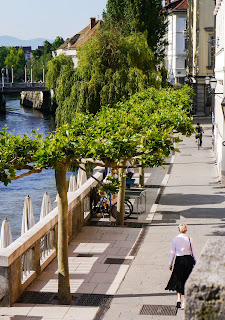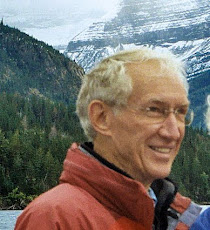Last Monday, Ann and I went to Town Hall to hear Erika Lee,
author of America For Americans, not as the title might
suggest a Trumpian screed, but a clear-eyed look at the distressing history of American
xenophobia. Lee, a Professor of American
History at the Univ. of Minnesota, says “America does not have an immigration
problem but a xenophobia problem.” Her presentation brought to a head my ruminations
on immigration: my family’s in the 17thC and 18thC, Ann’s in the 19thC, those
around us today.
Grandfather Halley Templeton Waller was held up to my
sisters and me as an exemplary civic leader and public servant, a fighter for
civil rights and, especially, immigrants’ rights. After all, the KKK burned a
cross on his front yard, an image seared into the memory of his twelve-year-old
son, Fletcher Waller, our dad and my namesake.
 |
| Halley Waller and His Son Fletcher |
But as so often the case, when one digs into family lore, the simple,
one-dimensional myths give way to the complexity of human beings’ contradictions
and inconsistencies.
In 1880, Grandfather Waller, age three, was orphaned along
with his three brothers. Their father died of measles; his mother, they said,
of a broken heart 120 days later. The four
brothers, ranging from 18 months to 7 years, were parceled out in rural Vermont
to various aunts and uncles. All became well educated; three went on to medical
school. But Halley, an inspired, young Christian teacher, left in his third
year of medical school to take a position in the YMCA system.
In the first decade of the 20thC, having risen to Secretary
(equivalent to an Executive Director) of the Cambridge, Mass Y, he developed a
uniquely successful Americanization and Naturalization program to teach and develop
citizens out of the wave of Eastern European immigrants flooding our
shores. In 1912, the Seiberlings,
Goodrichs, and Firestones of Akron, Ohio called Halley Waller to Akron, where Charles
Goodyear’s development of vulcanized rubber coupled with explosive growth of
Detroit and Midwest auto manufacturing had created a booming industry with an insatiable
need for labor; those new, immigrant citizens would be just the thing. In the second decade of the 20thC, Akron –
“The Rubber Capital of the World -- was the fastest growing American city, blossoming
from 69,000 in 1910 to 208,000 by 1920. Most of those newcomers were native-born
whites from Appalachia – almost universally Protestant, mostly fundamentalist;
30,000 of new arrivals were European-born.
Halley Waller took over the Akron Y, expanding its facilities
and programs with the fulsome support of the industrialists of Akron. Halley became increasingly prominent in the
community. He was elected chair of the
Akron School board and was active on Chamber and other civic organizations. In both Akron’s schools and the Y’s programs,
he promoted celebration of ethnic traditions and an openness to “otherness” in
religion and culture. From his school
board post, he established five night schools to “teach Akron’s Aliens” as the Akron
Times put it. This was the Halley Waller
of family lore.
But digging into my aunt Sis’s store of clippings, scrap
books and his journals and researching Akron’s history, unearths a more nuanced
story.
World War I shut off the immigration faucet. Agents from industrial north fanned out into
the Southern States, offering rail passage, signing bounties and jobs in the
North: an escape from Jim Crow. The Great Migration had begun. Akron was just
as promising a destination as Chicago, Kansas City, Detroit, Cleveland, Pittsburgh or New
York. By 1920, Akron had 5,000 American
Negros – term of the time – among its citizens, looking for jobs, housing and
education. The Akron Y helped raise
funds and train staff to open – yes – "The Colored Branch" of the Akron YMCA, a
separate and by implication, segregated facility. Ouch.
With The Great Migration came a re-birth of the Klu Klux
Klan, this time in the north, railing against both African Americans seeking
opportunities and the “problem” with Catholic and Jewish immigrants from
Eastern and Southern Europe: America for white Protestants, thank you very much.
By 1920, the Summit County Klavern boasted the largest membership
in the nation, with local “dens” in every important town. The county sheriff was a Klansman, as were
the mayors of Toledo, Akron and many local union officials and business leaders.
In Akron, the issue wasn’t so much African-Americans as
Catholic and Jewish immigrants. What easier targets to attack than the YMCA and
the School Board. The Klan focused on public schools – mandatory reading of the
Bible, segregating black students from others, even trying (unsuccessfully) to
remove Catholic teachers. Their campaign
for school board seats in 1924 – that was when the Klan burned a cross on
Granddad’s front lawn -- paid off, and in 1925 wielded their majority on the
board to appoint a rabid Klansman from Southern Ohio to School Superintendent;
Halley and three other board members resigned in protest; their appointed
replacements were all Klan members.
In the same way, the Klan attacked the “West Akron Establishment”,
the business and civic leadership community, alleging that the Catholic
neighborhoods were receiving too much attention, the older but still recently
arrived families from Appalachia and Southern Ohio too little, and that
naturalization programs at the Y were just anti-unionism in disguise. The Klan infiltrated the rubber companies,
with many members among managers and employees, and became increasingly active
in the unions. All this took its toll;
the industrial donor base found the Y too hot a potato to handle and began to withdraw
its support.
Halley T. Waller, YMCA Secretary and School Board Chair, had
become prime target #1, a symbol of all the Klan and Super-patriot isolationists
and immigration opponents resented. In
1924, he gave a speech before the Akron C of C in opposition to the 1921
immigration quota restrictions and the even tougher Johnson-Reed immigration
act of 1924: admirable opposition. But –
to my amazement when I read the speech -- his reasoning was that reducing
immigration and basing quotas on population patterns of 1890 would skew US
population toward higher-birth-rate peoples of color and non-Christians already
here, steadily diluting the European Christian values that he felt were the
core of American culture: Double Ouch.
I was stunned to unearth that bias – the second and a major crack
in the picture of a fighter for immigration and civil rights. I had no clue
that color or non-Christians might have been his blind spot. He was not, I know, an explicit racist but,
apparently, was a believer in the superiority of northern European, Christian
values and culture. A man of his times
perhaps. But of ours?
Under reactionary pressure, Halley Waller resigned from the
Y in 1924; in protest, from the school board in 1925. (Dad was pulled out of the public school
system to matriculate from Case Western Reserve Academy.) Halley’s friend and ally, fellow Akronite
Wendell Willkie, took up the battle against the Klan.
As the Klan tide receded, Halley Waller again earned esteem as
a civic leader. But the culture wars had
taken a toll. By the mid-1930s, he had lost his zeal for Christian sectarianism. His journal entry for Feb 26,1936, for
example, reads in part:
“All the
deeply religious views expressed in my early journal entries are just so much
inherited misconceptions to put it mildly.
Baldly, I would call it “Bunk.”
Yet somehow, my estimate of my forebears’ beliefs and the evident
importance to them of these “beliefs” calls for a certain respect for which {sic]
evidently had great bearing upon the routine of their lives and the quality of
their character.”
Later on in that same entry he writes:
“I rather find to be true what I formerly considered almost
blasphemy, i.e., that men are wont to use religion as a cloak to gain their own selfish ends at the expense of an all too credulous mass who look
forward to the future life for their reward of their patient suffering here.”
But that did not dim his drive to serve his community. In the ‘30s, he headed a housing equity effort;
served on the local WPA board during the depression; chaired the Defense Bond
Drive in May of 1941; and during the war, served as regional director of the Office
of Price Administration. He died in the spring of ’45 without seeing the
victory over fascism he so ardently wished.
~~~~~~
The lessons, I guess, if any: no paragon goes
unblemished. Family lore burnishes
simplistic images; dig behind them to find the human, the strengths and
weaknesses, the admirable and the not-so.
On balance, I revere Halley Templeton Waller for his
opposition to xenophobes and hold him up to my grand-children as an admirable example
of public service and dedication to civic involvement, one well worthy of
emulation.
And of his son, Fletcher Waller? Yes, him too, but that is an
even longer story to be told another time.

















































